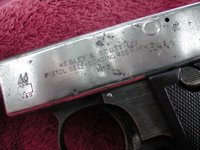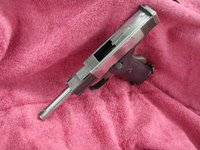Not at all a common find, these pistols were used by the Royal Navy during the Great War, as well as being fielded in small numbers by the Royal Flying Corps and Royal Horse Artillery. The RN discontinued their use shortly after the end of WWII, and many made their way through the usual surplus channels to the US, but their small numbers ensured that they would never be a common sight, even on the collecting scene. When one came into the shop as a box of parts and was revived by Shannon, such a rare beastie naturally caused a bit of a stir. Standing around with my gunsmith and a gentleman from one of the more active firearms importers, with probably sixty years in the gun biz between the three of us, not one of us could recollect having seen one in the steel before.
I had to have it.
 Unusually heavy, yet with an awkward grip angle, the pistol points like you're holding a t-square and may be the homeliest non-Japanese handgun I've ever seen. Oddly for a gun so rare, repro grips are available, and Triple-K has catalogued magazines. Cartridge cases can be made by trimming .45 Colt brass to length, turning the rim down somewhat (the .455 Webley Automatic is a semi-rimmed cartridge) and machining an extractor groove. The barrel rides in two angled mortises in the frame, and locks up very much like a SIG: a squared shoulder atop the chamber mating into the ejection port atop the slide. Everything is intricately machined from big chunks of steel and fitted together to a fare-thee-well.
Unusually heavy, yet with an awkward grip angle, the pistol points like you're holding a t-square and may be the homeliest non-Japanese handgun I've ever seen. Oddly for a gun so rare, repro grips are available, and Triple-K has catalogued magazines. Cartridge cases can be made by trimming .45 Colt brass to length, turning the rim down somewhat (the .455 Webley Automatic is a semi-rimmed cartridge) and machining an extractor groove. The barrel rides in two angled mortises in the frame, and locks up very much like a SIG: a squared shoulder atop the chamber mating into the ejection port atop the slide. Everything is intricately machined from big chunks of steel and fitted together to a fare-thee-well. Other odd features abound: The lockwork is assembled to the grip safety, and the whole mechanism pivots when the grip is squeezed. The pistol has dual ejectors, as well as two different methods of disconnecting (should one fail, the gun won't run away.) The recoil spring is a massive v-spring under the right-hand grip panel ("If the recoil spring breaks, you don't know me," said my gunsmith.) The slide stop is activated not by the magazine follower, but by the absence of a cartridge in the feedway. You don't need an empty magazine in the gun for the slide to lock back, it knows when it's empty. (I think that's a little presumptuous of it, but that's just me...) The drift-adjustable rear sight has little micrometer hashmarks to help line things up. All in all, a piece satisfying both in its historical provenance and in its mechanical quirkiness; I couldn't be happier to add one to the museum.
Other odd features abound: The lockwork is assembled to the grip safety, and the whole mechanism pivots when the grip is squeezed. The pistol has dual ejectors, as well as two different methods of disconnecting (should one fail, the gun won't run away.) The recoil spring is a massive v-spring under the right-hand grip panel ("If the recoil spring breaks, you don't know me," said my gunsmith.) The slide stop is activated not by the magazine follower, but by the absence of a cartridge in the feedway. You don't need an empty magazine in the gun for the slide to lock back, it knows when it's empty. (I think that's a little presumptuous of it, but that's just me...) The drift-adjustable rear sight has little micrometer hashmarks to help line things up. All in all, a piece satisfying both in its historical provenance and in its mechanical quirkiness; I couldn't be happier to add one to the museum.Values on these things are all over the map, but a firing example would seem to be at least an $800-$1000 proposition pretty much regardless of finish. The much rarer Royal Horse Artillery model, with its exotic rear sight and slotted for a shoulder stock, commands prices well north of $2k on the infrequent occasions when one comes up for sale.


15 comments:
I've never had the chance to see one of those before, thank you for showing it to us.
It seems like every British handgun I've ever seen is designed as if by someone who has seen a gun once, but never handled or fired one, and doesn't like them. Their handguns seem to be awkward, engineered by an amateur, and balanced wrong. I've examined some revolvers, the Webley and Enfield, and neither one impressed me as something that I would want other than as collector's items. But that's just my personal feelings.
I agree with you that the Japanese guns are some of the homeliest handguns, even more than a Dardick.
Too cool. Thanks for sharing. The Webley pistols, all of them, seem to seep the essence of Britain.
Now that I've finally had my fix, I might be able to wait until your next post... Maybe.
I can truly say that the webley pistols are great. I have one too, model from 1905 no.33. But I do not have more data about this pistol.
Will some one be nice and share some detail information about the gun.
I think you can easily make brass for the .455 Webley auto just by trimming down .45 Winchester Magnum pistol brass. Read it in some cartridge conversion book.
I have a webley and scott mark 4
38 revolver and would like to know the value of it if anyone can help?
i am tring to find out the value of a webley and scott mark 4
38 revolver. if any info please email me.. Sissy80623@aol.com
Thanks,
sissy
This is cool, I beleive I have the shoulder holster that the RHA used with this piece. Very neat to finally find the mate to it.
Thanks
David
david.bugg@verizon.net
May I use .45 ACP ammo in this pistols or in british colt 1911 in 455 automatic?
I have hear that people do shoot ACP in the .455 Webley, but I wouldn't, personally. There are slight differences in cartridge dimensions, and modern commercial .45ACP is a bit warmer than the old Webley load. (Although windage between the .451 bullet and .455 bore should relieve some of that.) As valuable as the old Webley Autos are, they're worth handloading to feed.
As far as the .455 Webley-chambered Colt autos, the strength of the gun is obviously up to it, and I don't see a problem. A regular Colt barrel should be a drop-in fit for range use, if one were so inclined, as well.
many thanks for info about colt 1911 .455 auto
Has anyone acctually shot one of these? I would be very curious to know how they preform
I have owned a 1913 made Mk1N pistol Serial 44* ( only 7000 made) for many years and still shoot it regularly, but now off shore as pistols are normally banned here in the UK.
Being a Brit. I am biased, but I think this pistol is one of the greats. It is extremely accurate with proper ammo, easily surpassing the 1911 pistol, which I am very familiar with. It is awkward in the grip, but once you are used to it, this is not a problem. It is too finely made and mud sensitive for use in the "trenches", but was great for for ships crews and the Royal Naval Air Service. My cases are modified .45 Long Colt brass and the bullet is the LEE 220 grain .456" RN ( sized to .455") made for the Ruger Old Army. Using 4.2 grains of Bullseye gives accuracy and reliable functioning with no undue stress on this rare old pistol.
Some comments on using .45 ACP in this pistol. The .45 Auto cartridge feeds and shoots ok in the .455 Webley auto , with satisfactory feeding and ejection. This is because the rim of the ACP case is held by the massive extractor from sliding too deep into the chamber, whilst being struck by the firing pin. However this practice is not recommended. First of all there is undue strain on the extractor and if you break it, a replacement would be very difficult to find. Also accuracy with .452" or .451" bullets is terrible. The groove diameter of the Webley is a true .455" (.4555" actually) and the rifling is very shallow. This contrasts with the Webley revolvers, most of which are .451" or .452" groove dia. with chamber mouths at around .448" (hence soft, hollow based bullets required) !!
Normal loadings in .45 ACP should not hurt this pistol (pressure wise) as it was originally designed for a much hotter cartridge. The service load was reduced to minimise danger when inevitably these rounds ( with their hard jacketed .455" bullets ) were chambered in Webley revolvers. This reduced load ammo contributed to the Webley Auto Pistol's unreliability in adverse conditions.
Its worth using a .455" blunt 220 grain bullet and making cases from .45 Long Colt brass. This process is easy if you have a lathe, but can be done efficiently with a power drill and a few hand tools.
Make a mandrel from a 30-06 case with the neck ( but not the shoulder) cut off and chuck it rim first into a drill clamped horizontally in your vice. The Long Colt cases now can be tapped onto your mandrel and spun. Part off the cases to approx length with a hacksaw blade and trim to length with a case trimmer (.918" is spec. but shorter is not critical as this semi rimmed case headspaces on the rim). Then remount the shortened case on the mandrel and cut an extractor groove in front of the rim with a doubled hack saw blade ( groove should be approx .435" dia) and chamfer the mouth side of the groove to resemble a .45 ACP type groove with a rough cut (bastard) file. Reduce the rim thickness to around .045" and rim diameter to about .500" with a fine cut file. All dimensions are + or - .005". Smooth and polish the groove with fine emery cloth.
"Modern and Antique Firearms" of the U.K. used to make excellent .455 SL cases commercially from .45 LC. brass. They are still in business, but I don't know whether they can still supply these cases
Hi, i dont know much but what i do know is that I have a Webley air pistol "Senior" in its box. can someone tell me something about it, where I could safely sell it etc.
thomas71nz@yahoo.c.nz
we have a webley and scott pistol .455 the same one as in the pictures that we would like to sell if any one is interrested please contact me on dleroux11@yaqhoo.com
Post a Comment